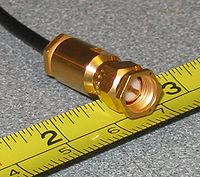SMA connector: Difference between revisions
No edit summary |
Tag: possible conflict of interest |
||
| Line 62: | Line 62: | ||
* [http://www.wa1mba.org/rfconn.htm RF Connectors from WA1MBA] |
* [http://www.wa1mba.org/rfconn.htm RF Connectors from WA1MBA] |
||
* [http://www.cmpter.com/sma-connecotrs.htm Coaxial SMA Connectors from CMPTER] |
* [http://www.cmpter.com/sma-connecotrs.htm Coaxial SMA Connectors from CMPTER] |
||
* [http://www.wellshow.com/technical-support/connector-support/what-is-an-sma-connector/ How to identify a SMA RF Connector, straight, Right Angle, Plug, Jack, Bulkhead, PCB] |
|||
{{commonscat|Connectors}} |
{{commonscat|Connectors}} |
||
Revision as of 13:58, 27 August 2010


SMA (SubMiniature version A) connectors are coaxial RF connectors developed in the 1960s as a minimal connector interface for coaxial cable with a screw type coupling mechanism. The connector has a 50 Ω impedance. It offers excellent electrical performance from DC to 18 GHz.
Connector design
The SMA connector consists of a 0.250x36 thread. The male is equipped with a .312 inch (7.925mm) hex nut.
The outer shell of the male or plug connector has an inside thread and an inner pin, which can be confusing. In conventional SMA, the terms "male" and "female" refer exclusively to the inner pin or socket of the connectors. The male connector is also commonly referred to as a "plug", whereas the female connector is also known as a "socket" or "jack".
The SMA connector uses a polytetrafluoroethylene (PTFE) dielectric which will contact along the mating plane. Variability in the construction and the mating of the connectors limit the repeatability of the connector impedance. For that reason, an SMA connector is not a good choice for metrological applications.
SMA connectors are rated for 500 mating cycles, but to achieve this it is necessary to properly torque the connector when making the connection. A 5/16 inch torque wrench is required for this, set to 3-5 in·lbf (0.3 to 0.6 N·m) for brass, and 7-10 in·lbf (0.8–1.1 N·m) for stainless steel connectors. Flats are also provided on the cable side of the connector assembly so that a second wrench can be used to prevent it rotating and damaging the joint to the cable. It is also advisable to clean out loose debris from the internal surfaces with compressed air before mating.
Variations
The SMA connector is typically rated for mode-free operation from DC to 18 GHz, though some proprietary versions are rated to 26.5 GHz. For performance above this, SMA-like connectors are used. These are the 3.5 mm connector, rated to 34 GHz, and the 2.92 mm (also known as 2.9 mm), good up to 46 GHz. These connectors keep the same outside thread as the SMA, so they can all be cross-mated, however they use an air dielectric, with the center conductors appropriately scaled. However, the life of the precision connector will be reduced, and can be easily damaged when mating with low-grade SMA connectors.
Beyond 46 GHz, the 2.4 mm, 1.85 mm and the 1 mm connector exist. These are similar to the SMA connector, but with the geometries incompatibly scaled. These have mode-free operation to 50, 65, and 110 GHz respectively.
Reverse polarity SMA

Reverse polarity SMA (RP-SMA or RSMA) is a proprietary variation of the SMA connector specification which reverses the gender of the interface, as shown in Figures 1 and 2. The term "reverse polarity" here refers only to the connector gender, not in any way to the polarity of the signal.
There is much confusion surrounding the description of Reverse Polarity connectors. The correct terminology refers to RP-SMA plugs and RP-SMA sockets, which are female and male respectively. However, non-technical people are much more at home with references to male and female. Thus, there is widespread use of terms RP-SMA male (socket), and RP-SMA Female (Plug).
The RP-SMA plug connector has the same external housing as a standard or conventional SMA plug connector, which consists of an outer shell with the thread on the inside; however, the internal prong or pin is replaced by a receptacle or female inner pin. Similarly, an RP-SMA male has a pin like a conventional male, but is housed in a socket rather than a standard plug connector. The RP-SMA female connector keeps the female receptacle, but is housed in a plug casing. In other words, the association of "plug" to "male" , and "socket" to "female" is reversed.
People at home with using the term "Reverse SMA Plug" often make the mistake of assuming "Reverse SMA Male" is the same thing, perpetuating the widespread misunderstanding. This has led to confusion due to the popular belief that connectors with pins are male.
| Male Pin | Female Receptacle | |
|---|---|---|
| Inner Thread
(outer nut/shell) |
SMA Plug / SMA Male | Reverse SMA Plug / Reverse SMA Female |
| Outer Thread | Reverse SMA Socket / Reverse SMA Male | SMA Socket / SMA Female |
RP-SMA connectors are widely used by Wi-Fi equipment manufacturers to comply with specific local regulations {Section 15.203 Antenna requirement}, e.g. the FCC, which are designed to make it difficult for consumers to connect antennas with gain and thereby breach compliance.
See also
- SMB connector
- SMC connector
- TNC connector, also has RP-TNC version used for Wi-Fi
References
- Radio-frequency connectors. Part 15: R.F. coaxial connectors with inner diameter of outer conductor 4.13 mm (0.163 in) with screw coupling — Characteristic impedance 50 ohms (Type SMA). International Standard IEC 60169-15, 1979.
- CECC 22110/111
- Connectors, plug, electrical, radio frequency. Military specification sheet MIL-C-39012.
- 47 C.F.R. Section 15.203 Antenna requirements.
External links
- RF Connectors from WA1MBA
- Coaxial SMA Connectors from CMPTER
- How to identify a SMA RF Connector, straight, Right Angle, Plug, Jack, Bulkhead, PCB
